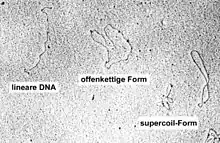plasmid
English

Plasmids
Etymology
From plasma + -id, coined 1952 by American molecular biologist Joshua Lederberg.
Pronunciation
- IPA(key): /ˈplæzmɪd/
Noun
plasmid (plural plasmids)
- (cytology) A loop of double-stranded DNA that is separate from and replicates independently of the chromosomes, most commonly found in bacteria, but also in archaeans and eukaryotic cells, and used in genetic engineering as a vector for gene transfer.
- 1952 October 1, J. Lederberg, “Cell genetics and hereditary symbiosis”, in Physiological Reviews, volume 32, number 4, page 403:
- These discussions have left a plethora of terms adrift: pangenes, bioblasts, plasmagenes, plastogenes, chondriogenes, cytogenes and proviruses, which have lost their original utility owing to the accretion of vague or contradictory connotations. At the risk of adding to this list, I propose plasmid as a generic term for any extrachromosomal hereditary determinant.
- 1999, Matt Ridley, Genome, Harper Perennial, published 2004, page 247:
- Bacteria are happy to absorb little rings of DNA called plasmids and adopt them as their own.
- 2004, Karl Friehs, “Plasmid Copy Number and Plasmid Stability”, in M. Beyer, T. Scheper, editors, New Trends and Developments in Biochemical Engineering, volume 86, page 47:
- Plasmids have an essential impact on productivity. Related factors are plasmid copy number, structural plasmid stability and segregational plasmid stability.
-
Derived terms
Translations
loop of double-stranded DNA that is separate from the chromosomes
This article is issued from Wiktionary. The text is licensed under Creative Commons - Attribution - Sharealike. Additional terms may apply for the media files.